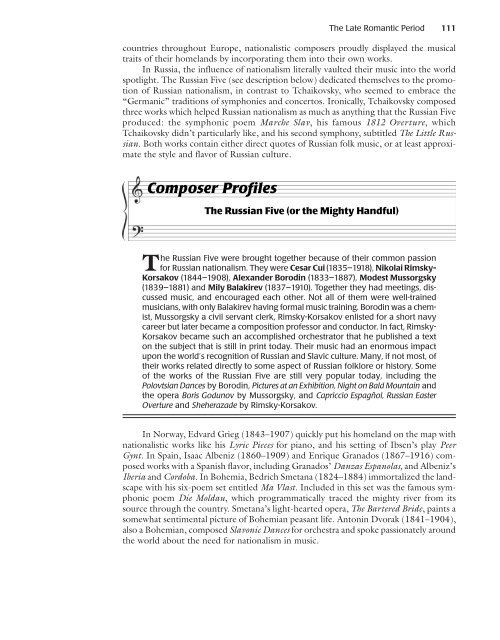Composer Profile - Activefolio
Composer Profile - Activefolio
Composer Profile - Activefolio
You also want an ePaper? Increase the reach of your titles
YUMPU automatically turns print PDFs into web optimized ePapers that Google loves.
The Late Romantic Period 111<br />
countries throughout Europe, nationalistic composers proudly displayed the musical<br />
traits of their homelands by incorporating them into their own works.<br />
In Russia, the influence of nationalism literally vaulted their music into the world<br />
spotlight. The Russian Five (see description below) dedicated themselves to the promotion<br />
of Russian nationalism, in contrast to Tchaikovsky, who seemed to embrace the<br />
“Germanic” traditions of symphonies and concertos. Ironically, Tchaikovsky composed<br />
three works which helped Russian nationalism as much as anything that the Russian Five<br />
produced: the symphonic poem Marche Slav, his famous 1812 Overture, which<br />
Tchaikovsky didn’t particularly like, and his second symphony, subtitled The Little Russian.<br />
Both works contain either direct quotes of Russian folk music, or at least approximate<br />
the style and flavor of Russian culture.<br />
<strong>Composer</strong> <strong>Profile</strong>s<br />
The Russian Five (or the Mighty Handful)<br />
The Russian Five were brought together because of their common passion<br />
for Russian nationalism. They were Cesar Cui (1835–1918), Nikolai Rimsky-<br />
Korsakov (1844–1908), Alexander Borodin (1833–1887), Modest Mussorgsky<br />
(1839–1881) and Mily Balakirev (1837–1910). Together they had meetings, discussed<br />
music, and encouraged each other. Not all of them were well-trained<br />
musicians, with only Balakirev having formal music training. Borodin was a chemist,<br />
Mussorgsky a civil servant clerk, Rimsky-Korsakov enlisted for a short navy<br />
career but later became a composition professor and conductor. In fact, Rimsky-<br />
Korsakov became such an accomplished orchestrator that he published a text<br />
on the subject that is still in print today. Their music had an enormous impact<br />
upon the world’s recognition of Russian and Slavic culture. Many, if not most, of<br />
their works related directly to some aspect of Russian folklore or history. Some<br />
of the works of the Russian Five are still very popular today, including the<br />
Polovtsian Dances by Borodin, Pictures at an Exhibition, Night on Bald Mountain and<br />
the opera Boris Godunov by Mussorgsky, and Capriccio Espagñol, Russian Easter<br />
Overture and Sheherazade by Rimsky-Korsakov.<br />
In Norway, Edvard Grieg (1843–1907) quickly put his homeland on the map with<br />
nationalistic works like his Lyric Pieces for piano, and his setting of Ibsen’s play Peer<br />
Gynt. In Spain, Isaac Albeniz (1860–1909) and Enrique Granados (1867–1916) composed<br />
works with a Spanish flavor, including Granados’ Danzas Espanolas, and Albeniz’s<br />
Iberia and Cordoba. In Bohemia, Bedrich Smetana (1824–1884) immortalized the landscape<br />
with his six-poem set entitled Ma Vlast. Included in this set was the famous symphonic<br />
poem Die Moldau, which programmatically traced the mighty river from its<br />
source through the country. Smetana’s light-hearted opera, The Bartered Bride, paints a<br />
somewhat sentimental picture of Bohemian peasant life. Antonin Dvorak (1841–1904),<br />
also a Bohemian, composed Slavonic Dances for orchestra and spoke passionately around<br />
the world about the need for nationalism in music.



